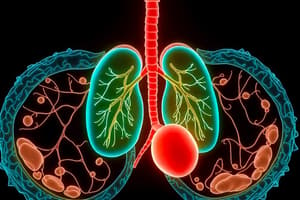Podcast
Questions and Answers
Where does glycolysis mainly occur?
Where does glycolysis mainly occur?
- Inside and outside of mitochondria (correct)
- Only inside mitochondria
- In the nucleus
- Outside of mitochondria
Which stage of cellular respiration involves redox reactions?
Which stage of cellular respiration involves redox reactions?
- Citric Acid Cycle (correct)
- Glycolysis
- Photosynthesis
- Electron Transport Chain
What is the primary function of the Electron Transport Chain in cellular respiration?
What is the primary function of the Electron Transport Chain in cellular respiration?
- Produce additional high-energy electrons
- Convert oxygen to carbon dioxide
- Convert glucose to pyruvate
- Transfer electrons derived from previous pathways to generate ATP (correct)
Which cellular organelle is primarily responsible for carrying out cellular respiration in eukaryotic cells?
Which cellular organelle is primarily responsible for carrying out cellular respiration in eukaryotic cells?
What is the end product of glycolysis?
What is the end product of glycolysis?
How does photosynthesis relate to aerobic respiration in ecosystems?
How does photosynthesis relate to aerobic respiration in ecosystems?
What is the primary purpose of respiration in living systems?
What is the primary purpose of respiration in living systems?
In which type of respiration does the Krebs cycle or citric acid cycle occur?
In which type of respiration does the Krebs cycle or citric acid cycle occur?
When does anaerobic respiration typically occur in living organisms?
When does anaerobic respiration typically occur in living organisms?
What is the end product of the Krebs cycle or citric acid cycle in aerobic respiration?
What is the end product of the Krebs cycle or citric acid cycle in aerobic respiration?
Which process allows organisms to survive under low-oxygen conditions?
Which process allows organisms to survive under low-oxygen conditions?
In aerobic respiration, what is the source of chemical energy for all living beings?
In aerobic respiration, what is the source of chemical energy for all living beings?
Flashcards are hidden until you start studying
Study Notes
Life Processes: A Focus on Respiration
Life is driven by various processes that sustain organisms' growth, reproduction, and maintenance. Among these vital functions, respiration stands out as one of the most fundamental life processes. In this exploration, we will delve into the role of respiration within living systems and unpack its significance for maintaining life.
What Is Respiration?
Respiration refers to the biochemical process whereby cells extract energy from organic molecules through redox reactions — oxidation and reduction simultaneously occur. This process facilitates the breakdown of nutrients like glucose into simpler compounds, releasing energy that can be used by the cell to carry out essential tasks such as producing ATP (adenosine triphosphate), which serves as the primary source of chemical energy for all living beings.
Types of Respiration
There are two main types of respiration: aerobic and anaerobic respiration.
Anaerobic respiration occurs in environments with limited oxygen availability, like muscle tissue during high-intensity exercise or certain prokaryotes. Anaerobic respiration generates less ATP per unit of substrate compared to aerobic respiration, but it allows organisms to survive under low-oxygen conditions.
Conversely, aerobic respiration takes place when enough oxygen is available. It follows a more complex series of metabolic steps called the Krebs cycle or citric acid cycle, whose end product is ATP. Photosynthetic organisms also produce oxygen via photosynthesis, creating an environment conducive to aerobic respiration in their ecosystems.
Cellular Respiratory Pathways
The process of breaking down food into chemical energy consists of three distinct stages known as glycolysis, the citric acid cycle, and electron transport chain, occurring mainly inside mitochondria (in eukaryotic cells):
-
Glycolysis: Occurs both inside and outside of mitochondria, converting glucose to pyruvate while generating small amounts of ATP.
-
Citric Acid Cycle (Krebs cycle): Produces additional high-energy electrons and ATP via redox reactions involving enzyme catalysts.
-
Electron Transport Chain: Transfers electrons derived from the previous two pathways along a protein chain, ultimately driving the synthesis of the bulk of ATP consumed by cells.
In summary, understanding the importance of respiration in sustaining life requires knowledge of the basic concepts, such as cellular respiratory pathways and their relationship to energy production. By appreciating the complexity and interconnectedness of life processes, we come away with a deeper appreciation for biological phenomena and our own existence.
Studying That Suits You
Use AI to generate personalized quizzes and flashcards to suit your learning preferences.




